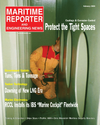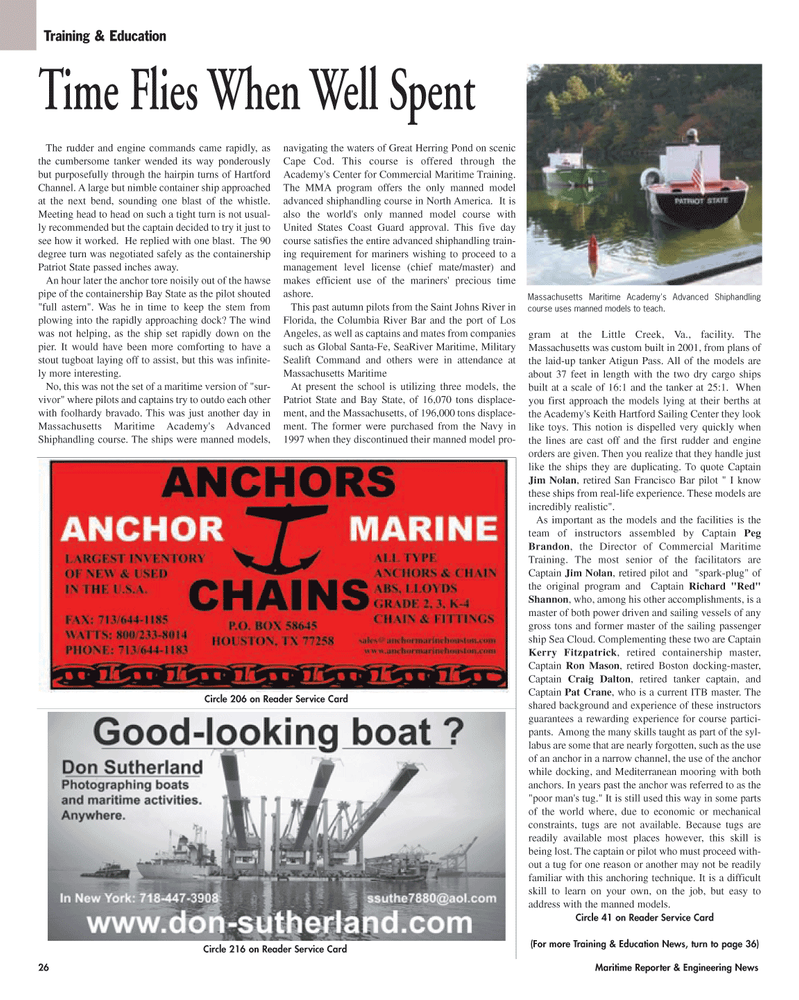
Page 26: of Maritime Reporter Magazine (February 2, 2005)
Read this page in Pdf, Flash or Html5 edition of February 2, 2005 Maritime Reporter Magazine
The rudder and engine commands came rapidly, as the cumbersome tanker wended its way ponderously but purposefully through the hairpin turns of Hartford
Channel. A large but nimble container ship approached at the next bend, sounding one blast of the whistle.
Meeting head to head on such a tight turn is not usual- ly recommended but the captain decided to try it just to see how it worked. He replied with one blast. The 90 degree turn was negotiated safely as the containership
Patriot State passed inches away.
An hour later the anchor tore noisily out of the hawse pipe of the containership Bay State as the pilot shouted "full astern". Was he in time to keep the stem from plowing into the rapidly approaching dock? The wind was not helping, as the ship set rapidly down on the pier. It would have been more comforting to have a stout tugboat laying off to assist, but this was infinite- ly more interesting.
No, this was not the set of a maritime version of "sur- vivor" where pilots and captains try to outdo each other with foolhardy bravado. This was just another day in
Massachusetts Maritime Academy's Advanced
Shiphandling course. The ships were manned models, navigating the waters of Great Herring Pond on scenic
Cape Cod. This course is offered through the
Academy's Center for Commercial Maritime Training.
The MMA program offers the only manned model advanced shiphandling course in North America. It is also the world's only manned model course with
United States Coast Guard approval. This five day course satisfies the entire advanced shiphandling train- ing requirement for mariners wishing to proceed to a management level license (chief mate/master) and makes efficient use of the mariners' precious time ashore.
This past autumn pilots from the Saint Johns River in
Florida, the Columbia River Bar and the port of Los
Angeles, as well as captains and mates from companies such as Global Santa-Fe, SeaRiver Maritime, Military
Sealift Command and others were in attendance at
Massachusetts Maritime
At present the school is utilizing three models, the
Patriot State and Bay State, of 16,070 tons displace- ment, and the Massachusetts, of 196,000 tons displace- ment. The former were purchased from the Navy in 1997 when they discontinued their manned model pro- gram at the Little Creek, Va., facility. The
Massachusetts was custom built in 2001, from plans of the laid-up tanker Atigun Pass. All of the models are about 37 feet in length with the two dry cargo ships built at a scale of 16:1 and the tanker at 25:1. When you first approach the models lying at their berths at the Academy's Keith Hartford Sailing Center they look like toys. This notion is dispelled very quickly when the lines are cast off and the first rudder and engine orders are given. Then you realize that they handle just like the ships they are duplicating. To quote Captain
Jim Nolan, retired San Francisco Bar pilot " I know these ships from real-life experience. These models are incredibly realistic".
As important as the models and the facilities is the team of instructors assembled by Captain Peg
Brandon, the Director of Commercial Maritime
Training. The most senior of the facilitators are
Captain Jim Nolan, retired pilot and "spark-plug" of the original program and Captain Richard "Red"
Shannon, who, among his other accomplishments, is a master of both power driven and sailing vessels of any gross tons and former master of the sailing passenger ship Sea Cloud. Complementing these two are Captain
Kerry Fitzpatrick, retired containership master,
Captain Ron Mason, retired Boston docking-master,
Captain Craig Dalton, retired tanker captain, and
Captain Pat Crane, who is a current ITB master. The shared background and experience of these instructors guarantees a rewarding experience for course partici- pants. Among the many skills taught as part of the syl- labus are some that are nearly forgotten, such as the use of an anchor in a narrow channel, the use of the anchor while docking, and Mediterranean mooring with both anchors. In years past the anchor was referred to as the "poor man's tug." It is still used this way in some parts of the world where, due to economic or mechanical constraints, tugs are not available. Because tugs are readily available most places however, this skill is being lost. The captain or pilot who must proceed with- out a tug for one reason or another may not be readily familiar with this anchoring technique. It is a difficult skill to learn on your own, on the job, but easy to address with the manned models.
Circle 41 on Reader Service Card (For more Training & Education News, turn to page 36) 26 Maritime Reporter & Engineering News
Training & Education
Circle 216 on Reader Service Card
Circle 206 on Reader Service Card
Time Flies When Well Spent
Massachusetts Maritime Academy's Advanced Shiphandling course uses manned models to teach.
MR FEBRUARY 2005 #4 (25-32).qxd 2/2/2005 9:46 AM Page 2

 25
25

 27
27
